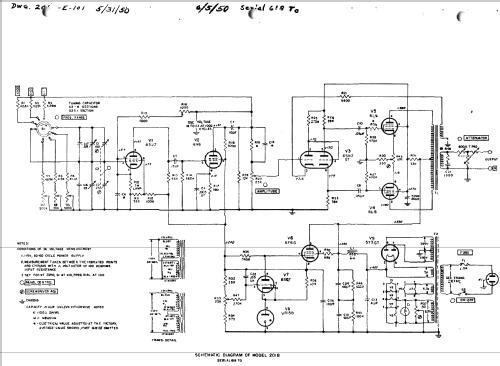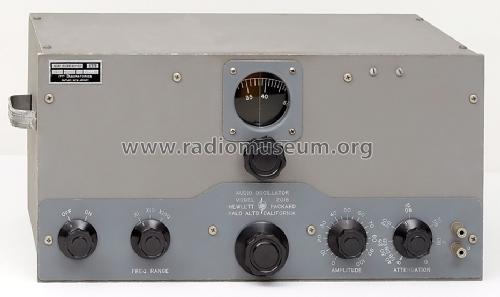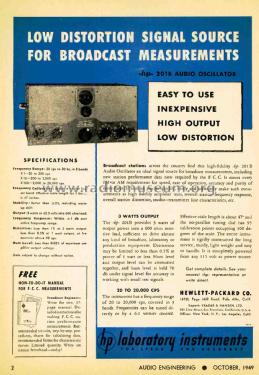Audio Oscillator 201B
Hewlett-Packard, (HP); Palo Alto, CA
- Pays
- Etats-Unis
- Fabricant / Marque
- Hewlett-Packard, (HP); Palo Alto, CA
- Année
- 1945 ?
- Catégorie
- Appareils de mesure et de dépannage (matériel de labo)
- Radiomuseum.org ID
- 223952
Cliquez sur la vignette du schéma pour le demander en tant que document gratuit.
- No. de tubes
- 9
- Gammes d'ondes
- - sans
- Tension / type courant
- Alimentation Courant Alternatif (CA) / 115 Volt
- Matière
- Boitier métallique
- De Radiomuseum.org
- Modèle: Audio Oscillator 201B - Hewlett-Packard, HP; Palo Alto
- Forme
- Modèle de table générique
- Dimensions (LHP)
- 18.75 x 8.625 x 11.75 inch / 476 x 219 x 298 mm
- Remarques
-
Frequency Range: 20 to 20000 cycles/sec in 3 ranges
Output: 3W into rated load (42.5V across a 600 Ohm load)
Distortion:
3W 1% from 50 to 20 kc
1W ½ from 50 to 20 kc
1W 1% from 20 to 20 kc
Hum: Less than 0.1% of rated output.
- Poids net
- 29 lb 0 oz (29 lb) / 13.166 kg
- Source
- -- Original-techn. papers.
- Auteur
- Modèle crée par Pius Steiner. Voir les propositions de modification pour les contributeurs supplémentaires.
- D'autres Modèles
-
Vous pourrez trouver sous ce lien 399 modèles d'appareils, 367 avec des images et 139 avec des schémas.
Tous les appareils de Hewlett-Packard, (HP); Palo Alto, CA
Contributions du forum pour ce modèle: Hewlett-Packard, HP;: Audio Oscillator 201B
Discussions: 1 | Publications: 1
Audio Oscillators
"From HP Catalog 18A" Laboratory Instruments", Copyrighted 1945."

ADVANTAGES:
3 Watts Output
Distortion Less Than 1/2%
Low Hum Level
New Dial with Ball Bearing Drive
Accurate Expanded Frequency calibration
Improved Control of Output Level
USE IT FOR:
High Fidelity Amplifier
Testing Transmission
Line Measurement
Loud Speaker Testing
Frequency Comparison
CHECK THE ADVANTAGES OF THIS FINE, NEW OSCILLATOR
In FM and other fields where high fidelity is important, this new -hp- Model 201B Audio Frequency Oscillator will meet every requirement for speed, ease of operation, accuracy and purity of wave form. The product of 6 years of -hp- oscillator development, this new oscillator has many brand new features, in addition to the revolutionary resistance-tuned circuit which has made -hp- a by-word in engineering circles.
The 201B has an accurate, convenient method of frequency control. The 6" dial, with smooth ball-bearing action, may be tuned by a directly controlled knob, or for still greater accuracy, may be set by the vernier which has a ratio of 6 to 1 to the main dial. The illuminated main dial is designed so that parallax is eliminated. It is calibrated over 300 degrees with approximately 95 calibration points and has an effective scale length of about 47 inches. Frequency range is 20 cps to 20 kc.
Increased Power Output
The amplifier delivers up to 3 watts of power into a 600 ohm resistance load, with distortion held to 1%. Thus there is sufficient power available for driving almost any kind of laboratory or production equipment. Harmonic distortion may be kept to less than ½ of 1%, if the output of the amplifier is limited to 1 watt.
Another important feature of this oscillator is the provision which is made for standardizing each frequency range against a reliable standard, such as -hp-'s Model 100B Secondary Frequency Standard. By standardizing the instrument regularly, frequencies can be depended upon to be better than 1% accurate.
Dual Control For Output Level
A new departure in oscillator design is the dual method for controlling output level. A volume control which is ahead of the amplifier controls the voltage at which the amplifier operates. An output attenuator is provided to attenuate the signal delivered by the amplifier. Attentuation is approximatelely linear from zero to 40 db. Both hum level and output voltage are thus attentuated together. As a result, hum level may be kept 60 db or more below the signal level, a special advantage in cases where small test signals are used.
The impedance looking back into the output circuit is about 50 ohms; thus the voltage regulation for varying loads is extremely good. For measurements where it is desirable to have impedance looking back into the instrument of 600 ohms, as in transmission measurements, the attenuator may be used to give about 6 db or more of attenuation, making the reflected impedance of the instrument about 600 ohms.
Important Details
Care has been taken to perfect every detail of this new oscillator. Improved chassis layout and placement of component parts minimizes thermal drift. The voltage on the oscillator is maintained constant with an electronic voltage regulator. The entire instrument is characterized by greater mechanical rigidity; the tuning assembly is mounted on a sturdy cast aluminum frame. The chassis itself is made of aluminum; the oscillator is light in weight and easy to handle.
SPECIFICATIONS MODEL 201B AF OSCILLATOR
Frequency Range: The frequency range is from 20 cps to 20,000 cps covered in three bands.
Band Frequency Coverage
x1 20 - 200 cps
x10 200 - 2000 cps
x100 2,000 - 20,000 cps
Frequency Calibration: The calibration is direct in cycles per second for the lowest band. Approximately 95 calibration points are provided over a 300-degree arc. The dial is 6 inches in diameter, illuminated and driven by a vernier knob having 6:1 ratio. The effective scale length for the three bands is 47 inches.
Stability: Under normal temperature conditions the frequency stability is better than ±2%, including the initial warm-up drift. Plus or minus 10% line voltage variations will result in no change in the output frequency. Adjustments are provided on each band to standardize the calibration against an accurately known frequency. With standardization the accuracy may be maintained better than ±1 %c.
Output: The instrument is rated at a maximum of 3 watts or 42.5 volts into a 600 ohm resistive load. Maximum no load voltage is at least 60 volts. The impedance looking back into the output circuit (zero attenuator setting) is approximately 75 ohms. With attenuator set at a value of 10 db or more the impedance looking back into the output is 600 ohms.
Frequency Response: The output voltage is constant within ±1 db over the frequency range of 20 cps to 20,000 cps.
Distortion: The total r.m.s. distortion of the output wave over the range of 20 cps to 20,000 cps is less than the following limits:
3 watts output 1% distortion
1 watt output .5% distortion*
*Down to 50 cps, at 20 cps 1% distortion.
Volume Control: Two controls are provided for varying the output of the instrument:
1. An "Amplitude Control" adjusts the amount of oscillator voltage fed to the output amplifier.
2. An "Attenuator" attenuates the output of the amplifier. It is a variable T Pad having an attenuation range of 0 to infinity. Approximately linear in region 0 to 40 db.
Hum Voltage: The hum voltage is less 0.1% of maximum output voltage. If the output attenuator is used to control the output (with Amplitude control set for maximum rated power output) the hum level will be less than .1% below any signal level.
Power Supply: 115 volts ±10%, 50/60 cycles. Power consumption: 75 watts. Plate supply voltage to oscillator section is electronically regulated.
Mounting: Cabinet Models are mounted in an aluminum cabinet finished in wrinkle grey. Size: 17 in. long x 8½ in. high x 11 in. deep.
Weight: 32 pounds. Shipping Weight: 46 pounds.
Pius Steiner, 25.Sep.12



